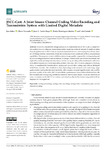Mostrar o rexistro simple do ítem
JSCC-Cast: A Joint Source Channel Coding Video Encoding and Transmission System with Limited Digital Metadata
| dc.contributor.author | Balsa, José | |
| dc.contributor.author | Fresnedo, Óscar | |
| dc.contributor.author | García-Naya, José A. | |
| dc.contributor.author | Domínguez-Bolaño, Tomás | |
| dc.contributor.author | Castedo, Luis | |
| dc.date.accessioned | 2021-12-29T09:39:31Z | |
| dc.date.available | 2021-12-29T09:39:31Z | |
| dc.date.issued | 2021 | |
| dc.identifier.citation | Balsa, J.; Fresnedo, Ó.; García-Naya, J.A.; Domínguez-Bolaño, T.; Castedo, L. JSCC-Cast: A Joint Source Channel Coding Video Encoding and Transmission System with Limited Digital Metadata. Sensors 2021, 21, 6208. https://doi.org/10.3390/s21186208 AMA Style | es_ES |
| dc.identifier.uri | http://hdl.handle.net/2183/29260 | |
| dc.description.abstract | [Abstract] This work considers the design and practical implementation of JSCC-Cast, a comprehensive analog video encoding and transmission system requiring a reduced amount of digital metadata. Suitable applications for JSCC-Cast are multicast transmissions over time-varying channels and Internet of Things wireless connectivity of end devices having severe constraints on their computational capabilities. The proposed system exhibits a similar image quality compared to existing analog and hybrid encoding alternatives such as Softcast. Its design is based on the use of linear transforms that exploit the spatial and temporal redundancy and the analog encoding of the transformed coefficients with different protection levels depending on their relevance. JSCC-Cast is compared to Softcast, which is considered the benchmark for analog and hybrid video coding, and with an all-digital H.265-based encoder. The results show that, depending on the scenario and considering image quality metrics such as the structural similarity index measure, the peak signal-to-noise ratio, and the perceived quality of the video, JSCC-Cast exhibits a performance close to that of Softcast but with less metadata and not requiring a feedback channel in order to track channel variations. Moreover, in some circumstances, the JSCC-Cast obtains a perceived quality for the frames comparable to those displayed by the digital one. | es_ES |
| dc.description.sponsorship | This work has been funded by the Xunta de Galicia (by grant ED431C 2020/15 and grant ED431G 2019/01 to support the Centro de Investigación de Galicia “CITIC”), the Agencia Estatal de Investigación of Spain (by grants RED2018-102668-T and PID2019-104958RB-C42), and ERDF funds of the EU (FEDER Galicia 2014–2020 and AEI/FEDER Programs, UE) | es_ES |
| dc.description.sponsorship | Xunta de Galicia; ED431C 2020/15 | es_ES |
| dc.description.sponsorship | Xunta de Galicia; ED431G 2019/01 | es_ES |
| dc.language.iso | eng | es_ES |
| dc.publisher | MDPI | es_ES |
| dc.relation | info:eu-repo/grantAgreement/AEI/Plan Estatal de Investigación Científica y Técnica y de Innovación 2017-2020/RED2018-102668-T/ES/RED COMONSENS | |
| dc.relation | info:eu-repo/grantAgreement/AEI/Plan Estatal de Investigación Científica y Técnica y de Innovación 2017-2020/PID2019-104958RB-C42/ES/AVANCES EN CODIFICACION Y PROCESADO DE SEÑAL PARA LA SOCIEDAD DIGITAL | |
| dc.relation.uri | https://doi.org/10.3390/s21186208 | es_ES |
| dc.rights | Atribución 4.0 Internacional | es_ES |
| dc.rights.uri | http://creativecommons.org/licenses/by/4.0/ | * |
| dc.subject | Analog processing | es_ES |
| dc.subject | Analog video encoding | es_ES |
| dc.subject | Analog video transmission | es_ES |
| dc.title | JSCC-Cast: A Joint Source Channel Coding Video Encoding and Transmission System with Limited Digital Metadata | es_ES |
| dc.type | info:eu-repo/semantics/article | es_ES |
| dc.rights.access | info:eu-repo/semantics/openAccess | es_ES |
| UDC.journalTitle | Sensors | es_ES |
| UDC.volume | 21 | es_ES |
| UDC.issue | 18 | es_ES |
| UDC.startPage | 6208 | es_ES |
| dc.identifier.doi | 10.3390/s21186208 |
Ficheiros no ítem
Este ítem aparece na(s) seguinte(s) colección(s)
-
GI-GTEC - Artigos [193]






